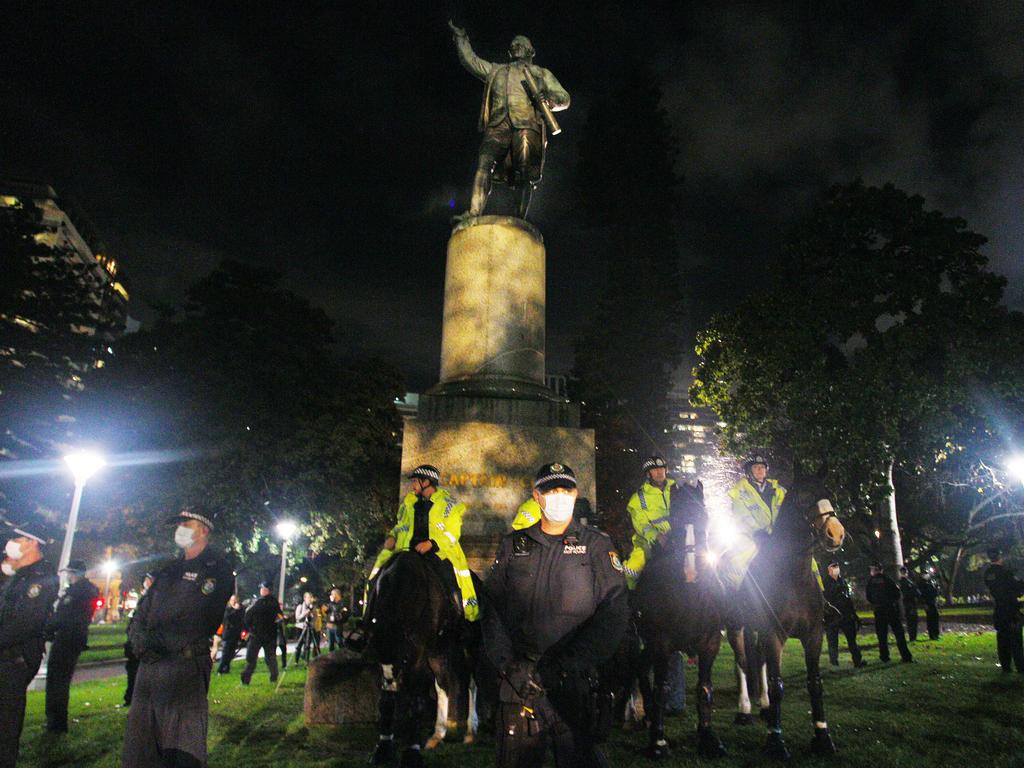
Seemingly old-fashioned to today’s observer, Woolner’s work was, by the standards of the time, remarkably modernist and designed to echo what Woolner, who spent several years on the Victorian goldfields before returning to England, felt was the Australian ethos.
As a leading member of the Pre-Raphaelite Brotherhood, with its emphasis on clarity of representation and on “uncompromising truth to what is”, the insistent naturalism of Woolner’s portrayal of Cook stood in stark contrast to the era’s conventional statues, which often wrapped contemporary figures in the togas of imperial Rome.
Cook’s slightly creased clothing, the scarcely visible insignia of rank, the look of genuine excitement in his eyes, the telescope in the left hand while the right hand points into space, recalling Cook’s pioneering observations of the sun’s eclipse and of the transit of Venus: all these highlighted Cook’s status as a self-made man imbued with the scientific and enterprising spirit of the age.
Funded in significant part by public subscription, and placed to greet settlers as they arrived on these shores, the statue magnificently captured the unbounded confidence of Australia’s young democracy.
Now it is reduced to a hostage in the sculpture wars. But farcical as those wars are, there is nothing new in battles over images: on the contrary, attacks on what they perceive as the graven idols of the past have been the stuff of revolutionary movements since time immemorial.
Initially, the impetus for those battles, at least in the West, sprang from within Christianity itself, as the strict prohibitions on idolatry Christianity inherited from the Hebrew Bible unleashed the waves of iconoclasm that swept Byzantium in the eighth and ninth centuries, Savonarola’s Florence in the 15th century and Reformation England from 1538 to 1643.
Recurring in each of those episodes, the burial, beheading or banishment of statues, in the belief that eliminating the symbol would cleanse the world of the evil it embodied, proved an enduring feature of Europe’s devastating religious conflicts.
Nor did the practice cease when the rise of absolutism brought those conflicts to a grudging truce. Rather, beginning in 1572 with the monumental bronze statue of Don Juan of Austria (which was the first statue specifically designed for display in a civic square and still graces the Sicilian town of Messina), the absolutist monarchs replaced religious imagery with towering images of the sovereign that expressed the ruler’s new-found power. Asserting their undivided control over the structures that could be erected, they permeated the public space with ever grander visual representations of their authority.
Absolutism thereby inaugurated the modern cult of the personality, with its use of monumental sculptures to make the leader eternal — a tradition that, after its initial expressions in the reigns of France’s Louis XIV and Prussia’s Frederick the Great, continued in Wilhelmine Germany and tsarist Russia before climaxing in the grotesque mausoleums that were planned, if not always completed, for Hitler, Lenin, Stalin and Mao.
At the same time, however, the modern cult of the personality fuelled a new, secular form of iconoclasm that took those representations of power as its target, in a counter-tradition that made its blood-soaked debut in the French Revolution’s systematic destruction of the material symbols of royalty. But the revolution, in destroying one purported “insult” to the “republican eye” after the other, also provoked a reaction that opened an entirely different path. Three terms, each put to new uses, marked the change.
Appalled at the revolutionaries’ disregard for the significance of the works they savaged, Abbe Gregoire, a priest who was a pioneering early abolitionist and supporter of universal suffrage, coined the word vandalism to describe the Jacobins’ conduct, likening them to the barbarians who wrecked in a day the heritage of centuries. At the same time, Kant, in responding to the revolution’s extremism, breathed new life into the ancient term fanaticism, describing it as a form of “thinking beyond reason”, which, by mistaking its phantasms of an ideal world for realities, was inherently hostile to liberty, common sense and rational deliberation.
Finally, Hegel developed the concept of “civil society” as a sphere of life that could avoid those dangers by regulating social interaction and promoting civility separately from, and free of, the coercive powers of the state.
Even if only implicitly, those features — the emphasis on cultural continuity, the predominant role of civil society and the avoidance of fanaticism — framed the role of public sculpture in the Australian colonies and in the other liberal democracies in the second half of the 19th century.
Combined with the steep decline technological change caused in the cost of casting busts and statues, the period’s rising wealth and growing social equality provoked an unprecedented explosion in the commissioning of monuments. No longer the prerogative of kings and great commanders, statues spread through cities and even small towns, honouring local pioneers, politicians, churchmen and schoolteachers — or, as Thomas Carlyle remarked in England, just about “anybody much heard of in the newspapers, and never yet convicted of felony”.
Spurred on by a sense of civic pride that we can only envy the “monumentolators”, as their critics called them, populated urban landscapes with the busts and statues that pepper our parks and public buildings. Were all those who were honoured saints? Surely not. Were some complicit in past wrongs? Undoubtedly so. Are there cases in which their actions ought to be put in context? Certainly yes. But seeking to wipe out the past, rather than coming to terms with it, is a reversion to the endless cycle of vandalism, fanaticism and wrenching social division the great thinkers of the Enlightenment denounced and that this country so fortunately avoided.
As for Woolner’s statue of Cook, the least one can ask of iconoclasts is that they should know their icons. Far from symbolising oppression, the statue embodies the virtues we ought to celebrate, both in Cook himself — with his boundless drive to study, discover and learn — and in Woolner’s grasp of Australia’s emerging character.
As long ago as 1420, Thomas Hoccleve, a great defender of images against the ravings of the iconoclasts, had one of the statues conjured up in his remarkable Lerne to Dye exclaim to its attackers, “I am not reedy in the grownd to creepe”.
With our cultural heritage under threat, neither should we.







When Thomas Woolner’s statue of Captain James Cook was unveiled in Sydney on February 25, 1879, The Sydney Morning Herald described the event, which attracted 70,000 spectators, as the “grandest spectacle” in Australian history, while Henry Parkes, whose government had commissioned it in 1875, proclaimed that “the genius of the thing quite thrilled”.